Popular categories
Looking for a yarn?
Mariella
DROPS jumper with cable pattern in Ardesia, Vienna or Melody. Size S – L.
DROPS Retro 1980-1993
Size: Ladies: S- M - L.
Materials:
DROPS Ardesia from Garnstudio
400-450-500 g color no 04, off-white
Or use:
DROPS Vienna from Garnstudio
400-450-500 g color no 21, off-white
Or use:
DROPS Melody from Garnstudio
300-350-400 g color no 01, off-white
DROPS pointed needles size 3 MM = US 2.5, 5.5 MM = US 9 (Vienna), 6 MM = US 10 (Ardesia) or 7 MM = US 10.75 (Melody)
DROPS small circular needle (40 cm = 16") size 3 MM = US 2.5.
-------------------------------------------------------
Alternative Yarn – See how to change yarns here
Yarn Groups A to F – Use the same pattern and change the yarn here
Yarn usage using an alternative yarn – Use our yarn converter here
-------------------------------------------------------
- English (US/in)
- Česky - not translated
- Dansk
- Deutsch
- Eesti keel
- English (UK/cm)
- Español
- Français
- Íslenska
- Italiano
- Magyar
- Nederlands
- Norsk
- Polski
- Português
- Suomi
- Svenska
- English (UK/cm), Bulgaria
- English (UK/cm), Croatia
- English (UK/cm), Greece
- English (UK/cm), Latvia
- English (UK/cm), Lithuania
- English (UK/cm), Romania
- English (UK/cm), Slovenia
- Česky, Slovakia - not translated
Pattern instructions
Ardesia:
10 x 10 cm = 4" x 4" = 12 sts x 20 rows in moss sts on needle 6.
Vienna:
10 x 10 cm = 4" x 4" = 13 sts x 22 rows in moss sts on needle 5.5.
Melody:
10 x 10 cm = 4" x 4" = 13 m x 20 rows in moss sts on needle 7.
Pattern: See diagram. The pattern is seen from the RS.
Rib: * K2, P2 *, repeat from * -*.
Seed st: Row 1: * K1, P1 *. Row 2: K over P and P over K. Repeat row 2.
Front piece: Worked back and forth on needle. Numbers in ( ) refer to Vienna. Cast on 66-70-72 (68-72-74) sts on circular needle size 3 mm and work 8 cm /3"" Rib. Change to circular needle size 6 / 7 mm and work 2 rows stockinette st, at the same time inc 10-12-14 (14-14-18) sts evenly on first row = 76-82-86 (82-86-92) sts. Work next row as follows from RS: 25-28-30 (28-30-33) seed sts, 26 sts cable pattern, 25-28-30 (28-30-33) seed sts. Continue in pattern like this. REMEMBER THE GAUGE! When piece measures 60-60-62 (60-60-62) cm bind off the middle 26 (28) sts for neck and bind off to shape the neckline on every other row: 2 sts 1 time, 1 st 2 times. Bind off remaining sts on shoulder when piece measures 64-64-66 (64-64-66) cm.
Back piece: Like front piece, but bind off the middle 32 (34) sts for neck when piece measures 62-62-64 (62-62-64) cm and dec 1 st on neckline on next row. Bind off remaining sts on shoulder when piece measures 64-64-66 (64-64-66) cm.
Sleeve: Cast on 32-36-36 (36-36-40) sts on needle size 3 mm / US 2.5 and work 6 cm / 2⅜" Rib. Change to needle size 6 / 7 mm and continue in seed st, at the same time inc 4-0-2 (2-4-0) sts evenly on first row = 36-36-38 (38-40-40) sts. At the same time after the Rib inc 1 st each side a total of 18-18-17 (20-19-19) times on every * 4th and 5th * row alternately for Ardesia/Melody and on every * 5th, 5th and 4th * row alternately for Vienna = 72-72-72 (78-78-78) sts. Bind off all sts when sleeve measures 51-49-48 (51-49-48) cm.
Assembly: Sew the shoulder seams. Pick up approx 72 (80) sts round neckline on circular needle size 3 mm and work 12 cm / 4¾" rib, bind off. Set in sleeves and sew side and sleeve seams.
Diagram
All measurements in charts are in cm.

|
= K 1, as seen from RS |

|
= P1, as seen from RS |

|
= slip 5 sts on cable needle in front of piece, K5, K5 from cable needle |

|
= slip 5 sts on cable needle behind piece, K5, K5 from cable needle. |
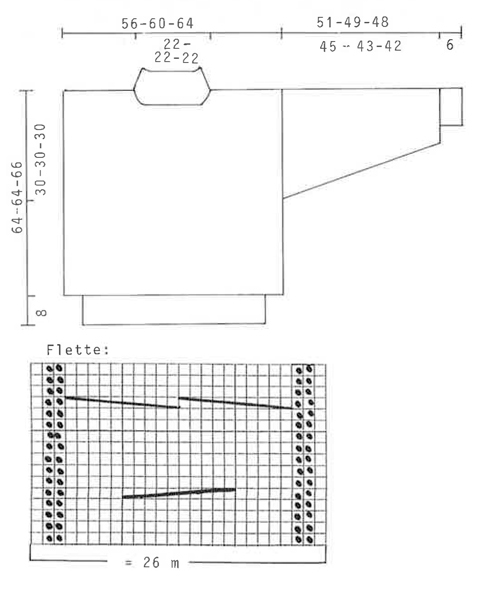
What can you do with our patterns? You can share DROPS patterns online, using the pattern original picture, materials, name and number. But you are NOT ALLOWED to reproduce the complete pattern digitally in any way. Yarn stores are welcome to use the DROPS pattern database to promote the sale of our assortment. You can print out our patterns, make as many copies as you’d like. The only thing we ask is that you don't make any changes / additions to the original printed document. And that the patterns according to the DROPS philosophy are given out to the consumers for free. Editorials that wish to publish our patterns in printed books or magazines can contact us for more information. The sale of garments based on DROPS patterns is permitted as long as they are sold as single items or per order. Further commercial use of the patterns is not permitted. It has to be clearly stated that the garment is made based on a design from DROPS DESIGN. The use of clothing labels of which DROPS DESIGN forms part is conditioned by the inclusion of the following text: “A DROPS DESIGN made by …..”. The use of DROPS photos for marketing purposes/sales is only permitted in connection with the use/sale of DROPS products. The photos may not be cut or edited and the logo should be clearly visible.
We reserve the right to withdraw the permission for use of our patterns at any time, notwithstanding the reason.
Each of our patterns has specific tutorial videos to help you.
These step-by-step tutorials might also help you:
Why is the knitting/crochet tension so important?
Knitting tension is what determines the final measurements of your work, and is usually measured per 10 x 10 cm. It is provided like so: number of stitches in width x number of rows in height - eg: 19 stitches x 26 rows = 10 x 10 cm.
The knitting tension is very individual; some people knit/crochet loosely while others work tightly. You adjust the knitting tension with the needle size, which is why the suggested needle size only serve as a guide! You need to adjust this (up or down) to ensure that YOUR knitting tension matches the knitting tension provided in the pattern. If you work with a different knitting tension than provided you will have a different yarn consumption, and your work will have different measurements than what the pattern suggests.
The knitting tension also determines which yarns can replace each other. As long as you achieve the same knitting tension you can replace one yarn with another.
See DROPS lesson: How to measure your tension/gauge
See DROPS video: How to make a gauge tension swatch
How do I know how many balls of yarn I need?
The required amount of yarn is provided in grams, eg: 450 g. To calculate how many balls you’ll need you first need to know how many grams are in 1 ball (25g, 50g or 100g). This information is available if you click on the individual yarn quality on our pages. Divide the amount required with the amount of each ball. For example, if each ball is 50g (the most common amount), the calculation will be as follows: 450 / 50 = 9 balls.
Can I use a different yarn than what the pattern suggests?
The important thing when changing from one yarn to another is that the knitting/crochet tension remains the same. This is so that the measurements of the finished piece will be the same as on the sketch provided. It is easier to achieve the same knitting tension using yarns from the same yarn group. It is also possible to work with multiple strands of a thinner yarn to achieve the knitting tension of a thicker one. Please try our yarn converter. We recommend you to always work a test swatch.
Please NOTE: when changing yarn the garment might have a different look and feel to the garment in the photo, due to individual properties and qualities of each yarn.
See DROPS lesson: Can I use a different yarn than the one mentioned in the pattern?
What are the yarn groups?
All our yarns are categorised into yarn groups (from A to F) according to thickness and knitting tension – group A contains the thinnest yarns and group F the thickest. This makes it easier for you to find alternative yarns to our patterns, should you wish to switch yarn. All yarns within the same group have a similar knitting tension and can easily replace each other. However, different yarn qualities have different structures and properties which will give the finished work a unique look and feel.
How do I use the yarn converter?
At the top of all our patterns you’ll find a link to our yarn converter, which is a helpful tool should you wish to use a different yarn than suggested. By filling in the yarn quality you wish to replace, the amount (in your size) and number of strands, the converter will present good alternative yarns with the same knitting tension. Additionally it will tell you how much you’ll require in the new qualities and whether you’ll need to work with multiple strands. Most skeins are 50g (some are 25g or 100g).
If the pattern is worked with multiple colours, every colour will have to be converted separately. Similarly, if the pattern is worked with several strands of different yarns (for example 1 strand Alpaca and 1 strand Kid-Silk) you will have to find alternatives for each, individually.
Why do you show discontinued yarns in the patterns?
Since different yarns have different qualities and textures we have chosen to keep the original yarn in our patterns. However, you can easily find options among our available qualities by using our yarn converter, or simply pick a yarn from the same yarn group.
It is possible that some retailers still have discontinued yarns in stock, or that someone has a few skeins at home that they would like to find patterns for.
The yarn converter will provide both alternative yarn as well as required amount in the new quality.
What size should I knit?
If you think it's hard to decide what size to make, it can be a good idea to measure a garment you own already and like the size of. Then you can pick the size by comparing those measures with the ones available in the pattern's size chart.
You'll find the size chart at the bottom of the pattern.
See DROPS lesson: How to read size chart
Why do I get the wrong knitting tension with the suggested needle size?
The needle size provided in the pattern serves only as a guide, the important thing is to follow the knitting tension. And since knitting tension is very individual, you will have to adjust the needle size to ensure that YOUR tension is the same as in the pattern – maybe you’ll have to adjust 1, or even 2 needle sizes, up or down to achieve the correct tension. For this, we recommend that you work test swatches.
Should you work with a different knitting tension than the one provided, the measurements of the finished garment might deviate from the measurement sketch.
See DROPS lesson: How to measure your tension/gauge
See DROPS video: How to make a gauge tension swatch
Why is the pattern worked top-down?
Working a garment top-down provides more flexibility and room for personal adjustment. For example it is easier to try the garment on while working, as well as making adjustments to length of yoke and shoulder caps.
The instructions are carefully explaining every step, in the correct order. Diagrams are adjusted to the knitting direction and are worked as usual.
How do I work according to a knitting diagram?
The diagram depicts all rows/rounds, and every stitch seen from the right side. It is read from bottom to top, from right to left. 1 square = 1 stitch.
When working back and forth, every other row is worked from the right side and every other row is worked from the wrong side. When working from the wrong side, the diagram will have to be worked reversed: from left to right, knit stitches are purled, purl stitches are knit etc.
When working in the round every round is worked from the right side and the diagram are worked from right to left on all rounds.
See DROPS lesson: How to read knitting diagrams
How do I work according to a crochet diagram?
The diagram depicts all rows/rounds, and every stitch seen from the right side. It is worked from bottom to top, from right to left.
When working back and forth every other row is worked from the right side: from right to left and every other row is worked from the wrong side: from left to right.
When working in the round, every row in the diagram are worked from the right side, from right to left.
When working a circular diagram you start in the middle and work your way outwards, counter clockwise, row by row.
The rows usually start with a given number of chain stitches (equivalent to the height of the following stitch), this will either be depicted in the diagram or explained in the pattern.
See DROPS lesson: How to read crochet diagrams
How do I work several diagrams simultaneously on the same row/round?
Instructions for working several diagrams after each other on the same row/round, will often be written like so: “work A.1, A.2, A.3 a total of 0-0-2-3-4 times". This means you work A.1 once, then A.2 is worked once, and A.3 is repeated (in width) the number of times provided for your size – in this case like so: S = 0 times, M = 0 times, L=2 times, XL= 3 times and XXL = 4 times.
The diagrams are worked as usual: begin with the first row in A.1, then work the first row in A.2 etc.
See DROPS lesson: How to read knitting diagrams
See DROPS lesson: How to read crochet diagrams
Why are the sleeves shorter in larger sizes?
The total width of the garment (from wrist-to-wrist) will be larger in the larger sizes, despite the actual sleeves being shorter. The larger sizes have longer sleeve caps and wider shoulders, so there will be a good fit in all sizes.
Where on the garment is the length measured?
The measurement sketch/schematic drawing provides information regarding the full length of the garment. If it’s a jumper or a jacket the length is measured from the highest point on the shoulder (usually closest to the neckline), and straight down to the bottom of the garment. It is NOT measured from the tip of shoulder. Similarly, the length of yoke is measured from the highest point on the shoulder and down to where yoke is split into body and sleeves.
See DROPS lesson: How to read a schematic drawing
What is a repeat?
Diagrams are often repeated on the round or in height. 1 repeat is the diagram the way it appears in the pattern. If it says to work 5 repeats of A.1 in the round, then you work A.1 a total of 5 times after/next to each other in the round. If it says to work 2 repeats of A.1 vertically/in height you work the entire diagram once, then begin again at the start and work the entire diagram one more time.
Why does the piece start with more chain stitches than it’s worked with?
Chain stitches are slightly narrower than other stitches and to avoid working the cast-on edge too tight, we simply chain more stitches to begin with. The stitch count will be adjusted on the following row to fit the pattern and measurement sketch.
Why increase before the rib edge when the piece is worked top-down?
The rib edge is more elastic and will contract slightly compared to, for example, stocking stitch. By increasing before the rib edge, you avoid a visible difference in width between the rib edge and the rest of the body.
Why increase in the cast-off edge?
It’s very easy to cast off too tightly, and by making yarn overs while casting off (and simultaneously casting these off) you avoid a too tight cast off edge.
See DROPS video: How to bind off with yarn overs (yo)
How do I increase/decrease on every 3rd and 4th row/round alternately?
To achieve an even increase (or decrease) you can increase on, for example: every 3rd and 4th row alternately, like so: work 2 rows and increase on the 3rd row, work 3 rows and increase on the 4th. Repeat this until the increase is complete.
See DROPS lesson: Increase or decrease 1 st on every 3rd and 4th row alternately
How can I work a jacket in the round instead of back and forth?
Should you prefer to work in the round instead of back and forth, you may of course adjust the pattern. You’ll need to add steeks mid-front (usually 5 stitches), and follow the instructions. When you would normally turn and work from the wrong side, simply work across the steek and continue in the round. At the end you’ll cut the piece open, pick up stitches to work bands, and cover the cut edges.
See DROPS video: How to knit steeks and cut open
Can I work a jumper back and forth instead of in the round?
Should you prefer to work back and forth instead of in the round, you may of course adjust the pattern so you work the pieces separately and then assemble them at the end. Divide the stitches for the body in 2, add 1 edge stitch in each side (for sewing) and work the front and back pieces separately.
See DROPS lesson: Can I adapt a pattern for circular needles into straight needles?
Why is the pattern slightly different than what I see in the photo?
Pattern repeats can vary slightly in the different sizes, in order to get the correct proportions. If you’re not working the exact same size as the garment in the photo, yours might deviate slightly. This has been carefully developed and adjusted so that the complete impression of the garment is the same in all sizes.
Make sure to follow instructions and diagrams for your size!
How do I make a women’s size garment into a men’s size one?
If you have found a pattern you like which is available in women’s size it’s not very difficult to convert it to men’s size. The biggest difference will be the length of sleeves and body. Start working on the women size that you think would fit across the chest. The additional length will be worked right before you cast off for the armhole/sleeve cap. If the pattern is worked top-down you can add the length right after the armhole or before the first decrease on sleeve.
Regarding additional yarn amount, this will depend on how much length you add, but it is better with a skein too many than too few.
How do I prevent a hairy garment from shedding?
All yarns will have excess fibres (from production) that might come off as lint or shedding. Brushed yarns (ie hairier yarns) have more of these loose, excess fibres, causing more shedding.
Shedding also depends on what is worn under or over the garment, and whether this pulls at the yarn fibres. It’s therefore not possible to guarantee that there will be no shedding
Below are some tips on how to get the best result when working with hairier yarns:
1. When the garment is finished (before you wash it) shake it vigorously so the looser hairs come off. NOTE: do NOT use a lint roller, brush or any method that pulls at the yarn.
2. Place the garment in a plastic bag and put it in your freezer - the temperature will cause the fibres to become less attached to each other, and excess fibres will come off easier.
3. Leave in the freezer for a few hours before taking it out and shaking it again.
4. Wash the garment according to the instructions on the yarn label.
Why does my garment pill?
Pilling is a natural process that happens to even the most exclusive of fibers. It's a natural sign of wear and tear that is hard to avoid, and that is most visible in high friction areas of your garment like a sweater's arms and cuffs.
You can make your garment look as new by removing the pilling, using a fabric comb or a pill/lint remover.
In the meantime, you can read the questions and answers that others have left to this pattern or join the DROPS Workshop on Facebook to get help from fellow knitters/crocheters!
You might also like...
Mariella |
|||||||||||||
 |
 |
||||||||||||
DROPS jumper with cable pattern in Ardesia, Vienna or Melody. Size S – L.
DROPS 16-17 |
|||||||||||||
|
Tension: Ardesia: 10 x 10 cm = 4" x 4" = 12 sts x 20 rows in moss sts on needle 6. Vienna: 10 x 10 cm = 4" x 4" = 13 sts x 22 rows in moss sts on needle 5.5. Melody: 10 x 10 cm = 4" x 4" = 13 m x 20 rows in moss sts on needle 7. Pattern: See diagram. The pattern is seen from the RS. Rib: * K2, P2 *, repeat from * -*. Seed st: Row 1: * K1, P1 *. Row 2: K over P and P over K. Repeat row 2. Front piece: Worked back and forth on needle. Numbers in ( ) refer to Vienna. Cast on 66-70-72 (68-72-74) sts on circular needle size 3 mm and work 8 cm /3"" Rib. Change to circular needle size 6 / 7 mm and work 2 rows stockinette st, at the same time inc 10-12-14 (14-14-18) sts evenly on first row = 76-82-86 (82-86-92) sts. Work next row as follows from RS: 25-28-30 (28-30-33) seed sts, 26 sts cable pattern, 25-28-30 (28-30-33) seed sts. Continue in pattern like this. REMEMBER THE GAUGE! When piece measures 60-60-62 (60-60-62) cm bind off the middle 26 (28) sts for neck and bind off to shape the neckline on every other row: 2 sts 1 time, 1 st 2 times. Bind off remaining sts on shoulder when piece measures 64-64-66 (64-64-66) cm. Back piece: Like front piece, but bind off the middle 32 (34) sts for neck when piece measures 62-62-64 (62-62-64) cm and dec 1 st on neckline on next row. Bind off remaining sts on shoulder when piece measures 64-64-66 (64-64-66) cm. Sleeve: Cast on 32-36-36 (36-36-40) sts on needle size 3 mm / US 2.5 and work 6 cm / 2⅜" Rib. Change to needle size 6 / 7 mm and continue in seed st, at the same time inc 4-0-2 (2-4-0) sts evenly on first row = 36-36-38 (38-40-40) sts. At the same time after the Rib inc 1 st each side a total of 18-18-17 (20-19-19) times on every * 4th and 5th * row alternately for Ardesia/Melody and on every * 5th, 5th and 4th * row alternately for Vienna = 72-72-72 (78-78-78) sts. Bind off all sts when sleeve measures 51-49-48 (51-49-48) cm. Assembly: Sew the shoulder seams. Pick up approx 72 (80) sts round neckline on circular needle size 3 mm and work 12 cm / 4¾" rib, bind off. Set in sleeves and sew side and sleeve seams. |
|||||||||||||
Diagram explanations |
|||||||||||||
|
|||||||||||||

|
|||||||||||||
|
Have you made this or any other of our designs? Tag your pictures in social media with #dropsdesign so we can see them! Do you need help with this pattern?You'll find tutorial videos, a Comments/Questions area and more by visiting the pattern on garnstudio.com. © 1982-2024 DROPS Design A/S. We reserve all rights. This document, including all its sub-sections, has copyrights. Read more about what you can do with our patterns at the bottom of each pattern on our site. |
|||||||||||||
With over 40 years in knitting and crochet design, DROPS Design offers one of the most extensive collections of free patterns on the internet - translated to 17 languages. As of today we count 304 catalogs and 11422 patterns - 11417 of which are translated into English (US/in).
We work hard to bring you the best knitting and crochet have to offer, inspiration and advice as well as great quality yarns at incredible prices! Would you like to use our patterns for other than personal use? You can read what you are allowed to do in the Copyright text at the bottom of all our patterns. Happy crafting!









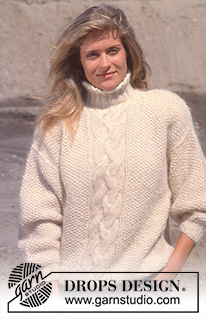
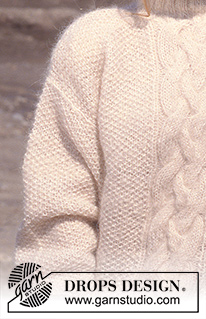
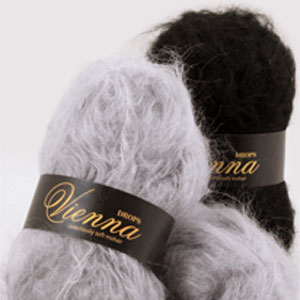





















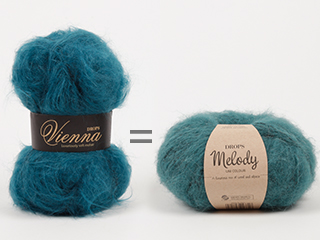






















Comments / Questions (12)
Bonjour, je reviens vers vous pour cette histoire d'encolure je tricote une taille m.
24.01.2023 - 06:09DROPS Design answered:
Bonjour Angelina, en taille M (avant les parenthèses), vous avez 82 mailles pour le devant, vous rabattez 26 mailles pour l'encolure = il reste 28 m pour chaque épaule, vous rabattez en début de rang à partir de l'encolure: 1 x 2 m (il reste 26 m) et 2 x 1 m (il reste 24 m). Pour le dos, vous rabattez les 32 m centrales, il reste 25 m pour chaque épaule puis 1 maille au début du rang suivant à partir de l'encolure = il reste 24 mailles. En espérant que ceci puisse vous aider. Bon tricot!
24.01.2023 - 12:14J'ai un soucis avec les épaules. Sur l'avant j'ai 17 mailles quand je rabats après les diminutions. Sur l'arrière j'en ai 25.. je ne vois pas comment assembler ça.
21.01.2023 - 14:27DROPS Design answered:
Bonjour Angelina, je trouve le même nombre de mailles pour les épaules du devant et du dos, soit 21-24-26 (23-25-28). Quelle taille tricotez-vous que nous puissions vous détailler l'encolure devant et dos?
23.01.2023 - 09:02Bonjour, Je n\'arrive pas à comprendre si le dos et le devant se tricote en une seule pièce en rond ou si je dois faire 2 pièces plates et les coudre ? La torsade doit elle être répétée dans le dos alors où n\'apparaît elle que sur l\'avant ? Merci
19.12.2022 - 07:52DROPS Design answered:
Bonjour Angelina, le dos et le devant se tricotent séparément, en allers et retours et de bas en haut. Le dos se tricote comme le devant = avec la torsade, mais on va rabattre les mailles de l'encolure plus tard que pour le devant. Bon tricot!
19.12.2022 - 10:07Hi It says in the beginning that my tension and needles should be different depending on the yarn I use. Then, it says I should use 5.5 for Vienna and Melody even tho they have different tensions? I want to make this sweater in double Drops Soft Tweed. What should my tension be and what size of needles? Thanks
18.10.2022 - 21:01DROPS Design answered:
Dear Mrs Moss, needle size have been updated for each yarn - you should use either 5,5 (Vienna) or 7 (Melody) - make sure to first knit a swatch checking the required needle size to get the tension then you can follow the pattern for either 5,5 or 7. Happy knitting!
20.10.2022 - 13:01Bonjour serais t'il possible d'avoir des modeles de pull col cheminée en jersey endroit aux aiguilles normales !! n'étant pas adepte pour les circulaires !!!cordialement !!
29.09.2022 - 16:12DROPS Design answered:
Bonjour Mme Malbranque, les aiguilles circulaires sont très utilisées en Scandinavie, pour tricoter en rond mais aussi pour tricoter en rangs; vous pouvez souvent très facilement adapter les modèles tricotés en aiguilles circulaires sur aiguilles droites, cette leçon pourra vous y aider. Bon tricot!
30.09.2022 - 07:58Wordt de kabel ook op het achterpand gebreid
26.09.2022 - 18:49DROPS Design answered:
Dag Mary,
Ja, het achterpand heeft ook kabels volgens het patroon.
27.09.2022 - 17:52Er det virkelig kun 66 m på p 3?? Den bliver kun 35 cm … det plejer at være mere, og på billedet ser den ikke så stram ud
03.09.2022 - 15:53DROPS Design answered:
Hei Line. Vrangbordene på -80-tallet var gjerne veldig stramt. Når vrangborden er ferdig strikket byttes det til større pinner og det øker masker. Se målene på målskissen nederst på oppskriften. Men legg gjerne opp flere masker om du ikke ønsker så stram vrangbord, bare være obs på at det da går mer garn. mvh DROPS Design
05.09.2022 - 13:13Bonjour Je souhaite tricoter ce pull en Mélody. Dois je suivre les instructions pour ardesia ou pour Vienna? Merci d avance pour votre réponse.
25.02.2021 - 15:18DROPS Design answered:
Bonjour Isabelle O, suivez les indications de Vienna, ce sont les mêmes - et la même tension en largeur que Melody, autrement dit: 13 m = 10 cm. Bon tricot!
25.02.2021 - 15:33I am not a very experienced knitter and therefore wondered whether you could explain how the cable section works. Many thanks.
13.02.2021 - 16:38DROPS Design answered:
Dear Clare, just below the pattern there are some tutorial videos, that can help you make this sweater, For the cables, THIS particular video can show you, how a basic cable is knitted. Also THIS lesson can help you understand how to read the diagrams. Happy Knitting!
13.02.2021 - 21:28Can i use chunky or double knit for this pattern?
18.07.2019 - 08:50DROPS Design answered:
Dear Elize, you can work this jumper with DROPS Melody (click here to read more about the yarn) - try our yarn converter to see any other alternatives, or contact your DROPS store for any assistance choosing the best alternative. Happy knitting!
18.07.2019 - 10:49